service indicator LINCOLN MKS 2016 Owners Manual
[x] Cancel search | Manufacturer: LINCOLN, Model Year: 2016, Model line: MKS, Model: LINCOLN MKS 2016Pages: 382, PDF Size: 3.81 MB
Page 4 of 382
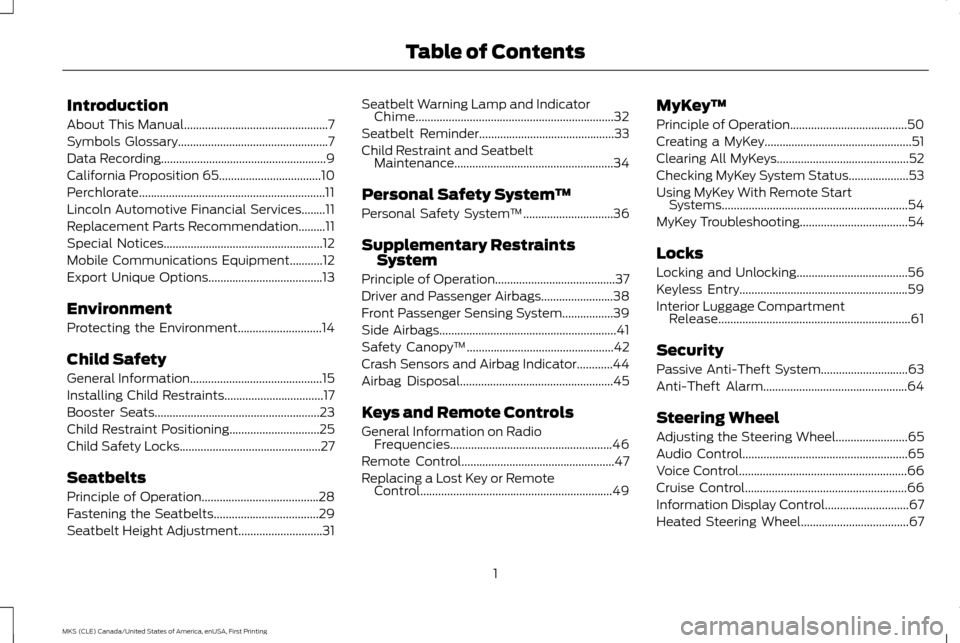
Introduction
About This Manual................................................7
Symbols Glossary..................................................7
Data Recording.......................................................9
California Proposition 65
..................................10
Perchlorate..............................................................11
Lincoln Automotive Financial Services........11
Replacement Parts Recommendation.........11
Special Notices
.....................................................12
Mobile Communications Equipment...........12
Export Unique Options......................................13
Environment
Protecting the Environment............................14
Child Safety
General Information............................................15
Installing Child Restraints.................................17
Booster Seats.......................................................23
Child Restraint Positioning
..............................25
Child Safety Locks
...............................................27
Seatbelts
Principle of Operation.......................................28
Fastening the Seatbelts
...................................29
Seatbelt Height Adjustment............................31 Seatbelt Warning Lamp and Indicator
Chime..................................................................32
Seatbelt Reminder
.............................................33
Child Restraint and Seatbelt Maintenance.....................................................34
Personal Safety System ™
Personal Safety System ™
..............................36
Supplementary Restraints System
Principle of Operation
........................................37
Driver and Passenger Airbags........................38
Front Passenger Sensing System.................39
Side Airbags...........................................................41
Safety Canopy ™
.................................................42
Crash Sensors and Airbag Indicator............44
Airbag Disposal
...................................................45
Keys and Remote Controls
General Information on Radio Frequencies......................................................46
Remote Control...................................................47
Replacing a Lost Key or Remote Control................................................................49 MyKey
™
Principle of Operation.......................................50
Creating a MyKey
.................................................51
Clearing All MyKeys............................................52
Checking MyKey System Status....................53
Using MyKey With Remote Start Systems..............................................................54
MyKey Troubleshooting....................................54
Locks
Locking and Unlocking.....................................56
Keyless Entry........................................................59
Interior Luggage Compartment Release................................................................61
Security
Passive Anti-Theft System.............................63
Anti-Theft Alarm................................................64
Steering Wheel
Adjusting the Steering Wheel
........................65
Audio Control
.......................................................65
Voice Control
........................................................66
Cruise Control
......................................................66
Information Display Control............................67
Heated Steering Wheel....................................67
1
MKS (CLE) Canada/United States of America, enUSA, First Printing Table of Contents
Page 7 of 382

Ordering Additional Owner's
Literature.........................................................220
Reporting Safety Defects (U.S. Only).......220
Reporting Safety Defects (Canada Only)...................................................................221
Fuses
Fuse Specification Chart...............................223
Changing a Fuse................................................237
Maintenance
General Information
.......................................240
Opening and Closing the Hood..................240
Under Hood Overview - 3.5L Ecoboost™.....................................................242
Under Hood Overview - 3.7L........................244
Engine Oil Dipstick...........................................245
Engine Oil Check...............................................245
Oil Change Indicator Reset...........................246
Engine Coolant Check.....................................247
Automatic Transmission Fluid Check......250
Brake Fluid Check.............................................254
Power Steering Fluid Check.........................254
Washer Fluid Check
.........................................254
Fuel Filter
.............................................................255
Changing the 12V Battery..............................255
Checking the Wiper Blades...........................257 Changing the Wiper Blades..........................257
Adjusting the Headlamps.............................258
Changing a Bulb
...............................................259
Bulb Specification Chart
...............................260
Changing the Engine Air Filter.....................262
Vehicle Care
General Information........................................263
Cleaning Products............................................263
Cleaning the Exterior
......................................264
Waxing
..................................................................265
Cleaning the Engine........................................265
Cleaning the Windows and Wiper Blades
...............................................................265
Cleaning the Interior
.......................................266
Cleaning the Instrument Panel and Instrument Cluster Lens............................266
Cleaning Leather Seats..................................267
Repairing Minor Paint Damage...................267
Cleaning the Alloy Wheels...........................268
Vehicle Storage
.................................................268
Wheels and Tires
Tire Care...............................................................270
Using Snow Chains
..........................................285
Tire Pressure Monitoring System...............286 Changing a Road Wheel................................289
Technical Specifications...............................294
Capacities and Specifications
Engine Specifications - 3.5L
Ecoboost™....................................................296
Engine Specifications - 3.7L.........................297
Motorcraft Parts - 3.5L Ecoboost™..........298
Motorcraft Parts - 3.7L...................................299
Vehicle Identification Number....................299
Vehicle Certification Label...........................300
Transmission Code Designation..................301
Capacities and Specifications - 3.5L Ecoboost™....................................................302
Capacities and Specifications - 3.7L.........307
Audio System
General Information.........................................313
Audio Unit - Vehicles With: Premium AM/ FM/CD...............................................................314
Media Hub
............................................................316
Accessories
Accessories..........................................................317
Extended Service Plan (ESP)
Extended Service Plan (ESP).......................319
4
MKS (CLE) Canada/United States of America, enUSA, First Printing Table of Contents
Page 44 of 382

Passenger airbag
Passenger airbag status indicator
Occupant
Disabled
OFF: Lit
Empty
ON: Unlit Disabled
OFF: Lit
Child
ON: Unlit Enabled
OFF: Unlit
Adult
ON: Lit
Note: When the passenger airbag status
indicator OFF light is illuminated, the
passenger (seat mounted) side airbag may be
disabled to avoid the risk of airbag deployment
injuries.
After all occupants have adjusted their seats
and put on safety belts, it is very important
that they continue to sit properly. A properly
seated occupant sits upright, leaning against
the seat back, and centered on the seat
cushion, with their feet comfortably extended
on the floor. Sitting improperly can increase the chance of injury in a crash event. For
example, if an occupant slouches, lies down,
turns sideways, sits forward, leans forward
or sideways, or puts one or both feet up, the
chance of injury during a crash is greatly
increased. Make sure the front passenger
sensing system is operating
properly. See Crash Sensors and
Airbag Indicator (page 44).
Do not attempt to repair or service the
system. Take your vehicle immediately to an
authorized dealer. If it is necessary to modify an advanced front
airbag system to accommodate a person
with disabilities, contact the Ford Customer
Relationship Center. See
Getting the
Services You Need (page 216).
SIDE AIRBAGS WARNINGS
Do not place objects or mount
equipment on or near the airbag cover,
on the side of the seatbacks (of the
front seats), or in front seat areas that may
come into contact with a deploying airbag.
Failure to follow these instructions may
increase the risk of personal injury in the
event of a crash.
41
MKS (CLE) Canada/United States of America, enUSA, First Printing Supplementary Restraints System
Page 45 of 382
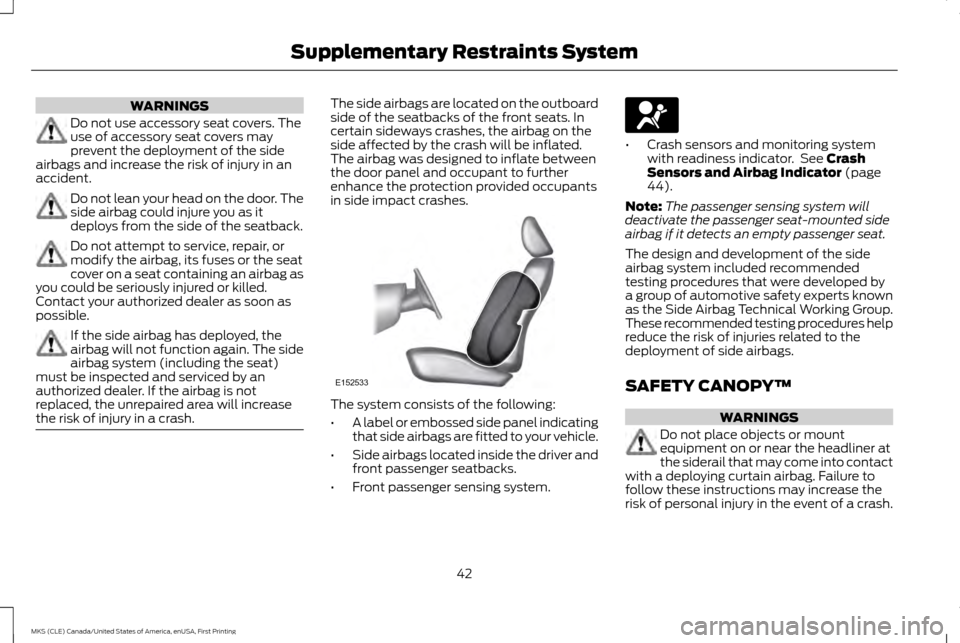
WARNINGS
Do not use accessory seat covers. The
use of accessory seat covers may
prevent the deployment of the side
airbags and increase the risk of injury in an
accident. Do not lean your head on the door. The
side airbag could injure you as it
deploys from the side of the seatback.
Do not attempt to service, repair, or
modify the airbag, its fuses or the seat
cover on a seat containing an airbag as
you could be seriously injured or killed.
Contact your authorized dealer as soon as
possible. If the side airbag has deployed, the
airbag will not function again. The side
airbag system (including the seat)
must be inspected and serviced by an
authorized dealer. If the airbag is not
replaced, the unrepaired area will increase
the risk of injury in a crash. The side airbags are located on the outboard
side of the seatbacks of the front seats. In
certain sideways crashes, the airbag on the
side affected by the crash will be inflated.
The airbag was designed to inflate between
the door panel and occupant to further
enhance the protection provided occupants
in side impact crashes.
The system consists of the following:
•
A label or embossed side panel indicating
that side airbags are fitted to your vehicle.
• Side airbags located inside the driver and
front passenger seatbacks.
• Front passenger sensing system. •
Crash sensors and monitoring system
with readiness indicator. See Crash
Sensors and Airbag Indicator (page
44).
Note: The passenger sensing system will
deactivate the passenger seat-mounted side
airbag if it detects an empty passenger seat.
The design and development of the side
airbag system included recommended
testing procedures that were developed by
a group of automotive safety experts known
as the Side Airbag Technical Working Group.
These recommended testing procedures help
reduce the risk of injuries related to the
deployment of side airbags.
SAFETY CANOPY™ WARNINGS
Do not place objects or mount
equipment on or near the headliner at
the siderail that may come into contact
with a deploying curtain airbag. Failure to
follow these instructions may increase the
risk of personal injury in the event of a crash.
42
MKS (CLE) Canada/United States of America, enUSA, First Printing Supplementary Restraints SystemE152533
Page 46 of 382

WARNINGS
Do not lean your head on the door. The
curtain airbag could injure you as it
deploys from the headliner.
Do not attempt to service, repair, or
modify the curtain airbags, its fuses,
the A, B, or C pillar trim, or the headliner
on a vehicle containing curtain airbags as you
could be seriously injured or killed. Contact
your authorized dealer as soon as possible. All occupants of your vehicle including
the driver should always wear their
safety belts even when an airbag
supplemental restraint system and curtain
airbag is provided. Failure to properly wear
your safety belt could seriously increase the
risk of injury or death. To reduce risk of injury, do not obstruct
or place objects in the deployment path
of the curtain airbag.
If the curtain airbags have deployed,
the curtain airbags will not function
again. The curtain airbags (including
the A, B and C pillar trim and headliner) must
be inspected and serviced by an authorized
dealer. If the curtain airbag is not replaced,
the unrepaired area will increase the risk of
injury in a crash. The Safety Canopy will deploy during
significant side crashes or when a certain
likelihood of a rollover event is detected by
the rollover sensor. The Safety Canopy is
mounted to the roof side-rail sheet metal,
behind the headliner, above each row of
seats. In certain sideways crashes or rollover
events, the Safety Canopy will be activated,
regardless of which seats are occupied. The
Safety Canopy is designed to inflate between
the side window area and occupants to
further enhance protection provided in side
impact crashes and rollover events. The system consists of the following:
•
Safety canopy curtain airbags located
above the trim panels over the front and
rear side windows identified by a label or
wording on the headliner or roof-pillar
trim.
• A flexible headliner which opens above
the side doors to allow air curtain
deployment · Crash sensors and monitoring
system with a readiness indicator.
See Crash Sensors and Airbag
Indicator (page 44).
Children 12 years old and under should
always be properly restrained in the rear
seats. The Safety Canopy will not interfere
with children restrained using a properly
installed child or booster seat because it is
designed to inflate downward from the
headliner above the doors along the side
window opening.
43
MKS (CLE) Canada/United States of America, enUSA, First Printing Supplementary Restraints SystemE75004
Page 47 of 382
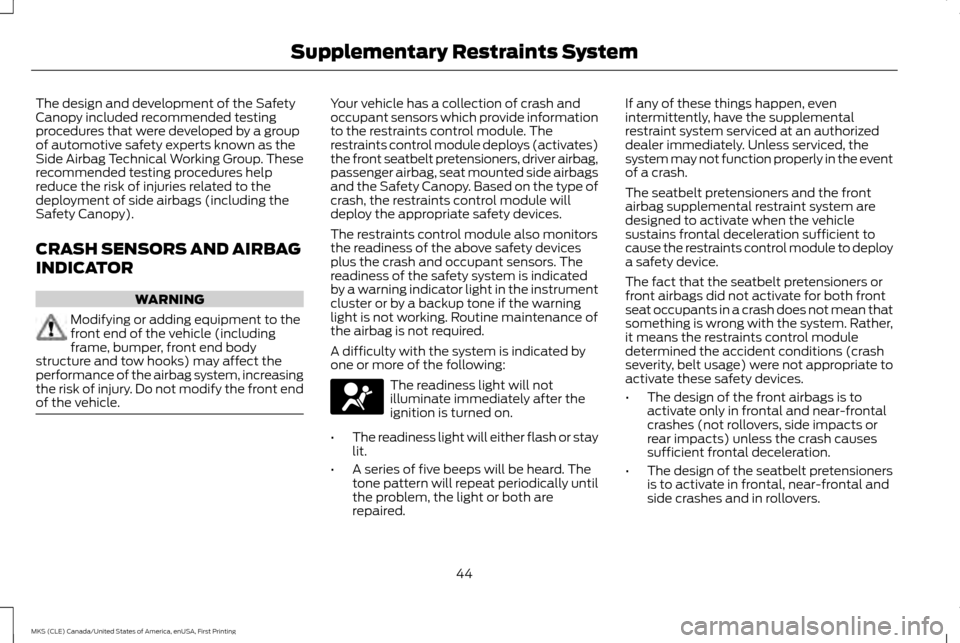
The design and development of the Safety
Canopy included recommended testing
procedures that were developed by a group
of automotive safety experts known as the
Side Airbag Technical Working Group. These
recommended testing procedures help
reduce the risk of injuries related to the
deployment of side airbags (including the
Safety Canopy).
CRASH SENSORS AND AIRBAG
INDICATOR
WARNING
Modifying or adding equipment to the
front end of the vehicle (including
frame, bumper, front end body
structure and tow hooks) may affect the
performance of the airbag system, increasing
the risk of injury. Do not modify the front end
of the vehicle. Your vehicle has a collection of crash and
occupant sensors which provide information
to the restraints control module. The
restraints control module deploys (activates)
the front seatbelt pretensioners, driver airbag,
passenger airbag, seat mounted side airbags
and the Safety Canopy. Based on the type of
crash, the restraints control module will
deploy the appropriate safety devices.
The restraints control module also monitors
the readiness of the above safety devices
plus the crash and occupant sensors. The
readiness of the safety system is indicated
by a warning indicator light in the instrument
cluster or by a backup tone if the warning
light is not working. Routine maintenance of
the airbag is not required.
A difficulty with the system is indicated by
one or more of the following:
The readiness light will not
illuminate immediately after the
ignition is turned on.
• The readiness light will either flash or stay
lit.
• A series of five beeps will be heard. The
tone pattern will repeat periodically until
the problem, the light or both are
repaired. If any of these things happen, even
intermittently, have the supplemental
restraint system serviced at an authorized
dealer immediately. Unless serviced, the
system may not function properly in the event
of a crash.
The seatbelt pretensioners and the front
airbag supplemental restraint system are
designed to activate when the vehicle
sustains frontal deceleration sufficient to
cause the restraints control module to deploy
a safety device.
The fact that the seatbelt pretensioners or
front airbags did not activate for both front
seat occupants in a crash does not mean that
something is wrong with the system. Rather,
it means the restraints control module
determined the accident conditions (crash
severity, belt usage) were not appropriate to
activate these safety devices.
•
The design of the front airbags is to
activate only in frontal and near-frontal
crashes (not rollovers, side impacts or
rear impacts) unless the crash causes
sufficient frontal deceleration.
• The design of the seatbelt pretensioners
is to activate in frontal, near-frontal and
side crashes and in rollovers.
44
MKS (CLE) Canada/United States of America, enUSA, First Printing Supplementary Restraints System
Page 90 of 382
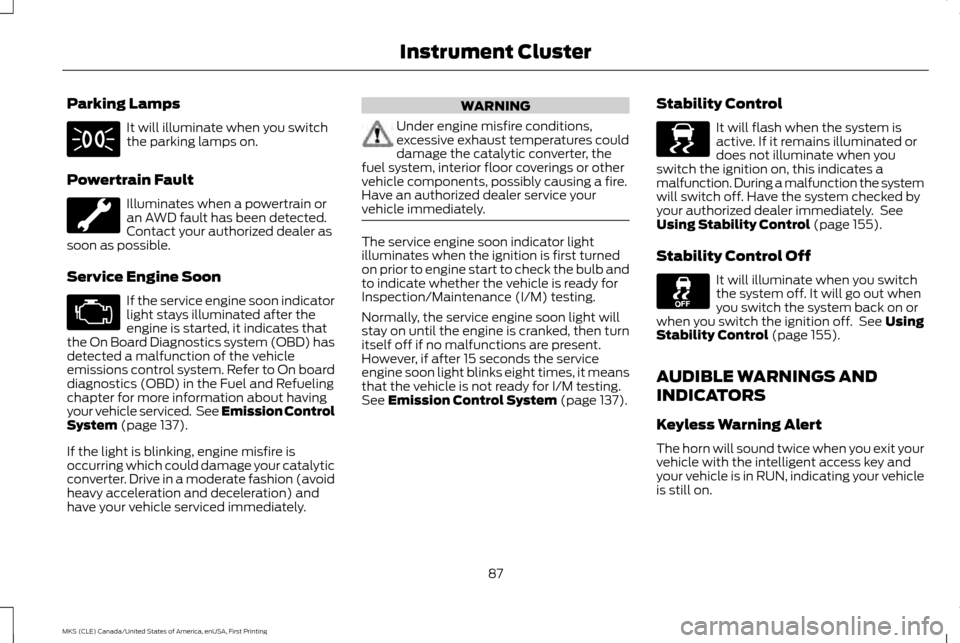
Parking Lamps
It will illuminate when you switch
the parking lamps on.
Powertrain Fault Illuminates when a powertrain or
an AWD fault has been detected.
Contact your authorized dealer as
soon as possible.
Service Engine Soon If the service engine soon indicator
light stays illuminated after the
engine is started, it indicates that
the On Board Diagnostics system (OBD) has
detected a malfunction of the vehicle
emissions control system. Refer to On board
diagnostics (OBD) in the Fuel and Refueling
chapter for more information about having
your vehicle serviced. See Emission Control
System (page 137).
If the light is blinking, engine misfire is
occurring which could damage your catalytic
converter. Drive in a moderate fashion (avoid
heavy acceleration and deceleration) and
have your vehicle serviced immediately. WARNING
Under engine misfire conditions,
excessive exhaust temperatures could
damage the catalytic converter, the
fuel system, interior floor coverings or other
vehicle components, possibly causing a fire.
Have an authorized dealer service your
vehicle immediately. The service engine soon indicator light
illuminates when the ignition is first turned
on prior to engine start to check the bulb and
to indicate whether the vehicle is ready for
Inspection/Maintenance (I/M) testing.
Normally, the service engine soon light will
stay on until the engine is cranked, then turn
itself off if no malfunctions are present.
However, if after 15 seconds the service
engine soon light blinks eight times, it means
that the vehicle is not ready for I/M testing.
See
Emission Control System (page 137).
Stability Control It will flash when the system is
active. If it remains illuminated or
does not illuminate when you
switch the ignition on, this indicates a
malfunction. During a malfunction the system
will switch off. Have the system checked by
your authorized dealer immediately. See
Using Stability Control
(page 155).
Stability Control Off It will illuminate when you switch
the system off. It will go out when
you switch the system back on or
when you switch the ignition off. See Using
Stability Control
(page 155).
AUDIBLE WARNINGS AND
INDICATORS
Keyless Warning Alert
The horn will sound twice when you exit your
vehicle with the intelligent access key and
your vehicle is in RUN, indicating your vehicle
is still on.
87
MKS (CLE) Canada/United States of America, enUSA, First Printing Instrument Cluster E138639
Page 140 of 382
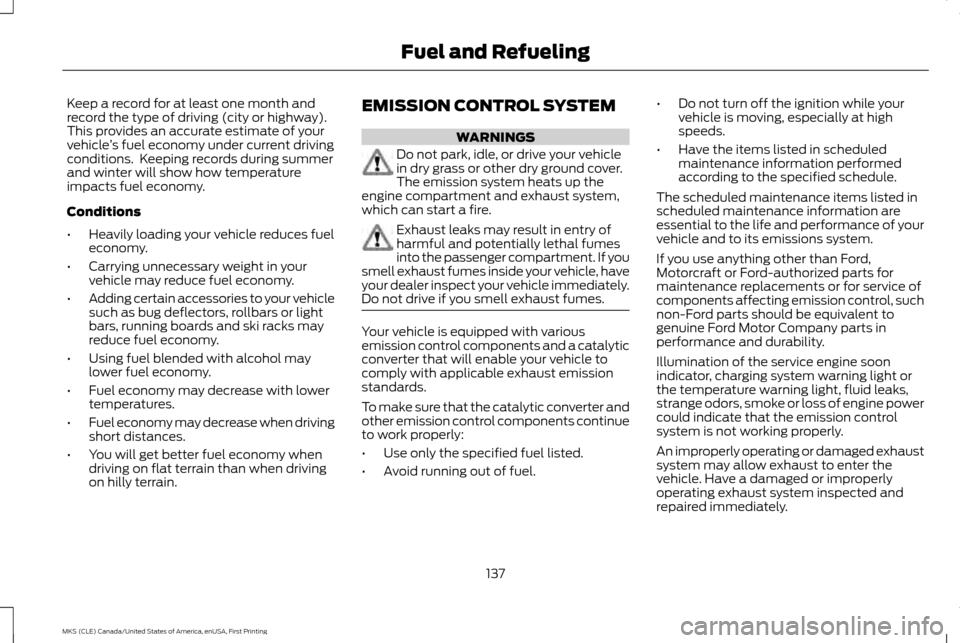
Keep a record for at least one month and
record the type of driving (city or highway).
This provides an accurate estimate of your
vehicle
’s fuel economy under current driving
conditions. Keeping records during summer
and winter will show how temperature
impacts fuel economy.
Conditions
• Heavily loading your vehicle reduces fuel
economy.
• Carrying unnecessary weight in your
vehicle may reduce fuel economy.
• Adding certain accessories to your vehicle
such as bug deflectors, rollbars or light
bars, running boards and ski racks may
reduce fuel economy.
• Using fuel blended with alcohol may
lower fuel economy.
• Fuel economy may decrease with lower
temperatures.
• Fuel economy may decrease when driving
short distances.
• You will get better fuel economy when
driving on flat terrain than when driving
on hilly terrain. EMISSION CONTROL SYSTEM WARNINGS
Do not park, idle, or drive your vehicle
in dry grass or other dry ground cover.
The emission system heats up the
engine compartment and exhaust system,
which can start a fire. Exhaust leaks may result in entry of
harmful and potentially lethal fumes
into the passenger compartment. If you
smell exhaust fumes inside your vehicle, have
your dealer inspect your vehicle immediately.
Do not drive if you smell exhaust fumes. Your vehicle is equipped with various
emission control components and a catalytic
converter that will enable your vehicle to
comply with applicable exhaust emission
standards.
To make sure that the catalytic converter and
other emission control components continue
to work properly:
•
Use only the specified fuel listed.
• Avoid running out of fuel. •
Do not turn off the ignition while your
vehicle is moving, especially at high
speeds.
• Have the items listed in scheduled
maintenance information performed
according to the specified schedule.
The scheduled maintenance items listed in
scheduled maintenance information are
essential to the life and performance of your
vehicle and to its emissions system.
If you use anything other than Ford,
Motorcraft or Ford-authorized parts for
maintenance replacements or for service of
components affecting emission control, such
non-Ford parts should be equivalent to
genuine Ford Motor Company parts in
performance and durability.
Illumination of the service engine soon
indicator, charging system warning light or
the temperature warning light, fluid leaks,
strange odors, smoke or loss of engine power
could indicate that the emission control
system is not working properly.
An improperly operating or damaged exhaust
system may allow exhaust to enter the
vehicle. Have a damaged or improperly
operating exhaust system inspected and
repaired immediately.
137
MKS (CLE) Canada/United States of America, enUSA, First Printing Fuel and Refueling
Page 141 of 382
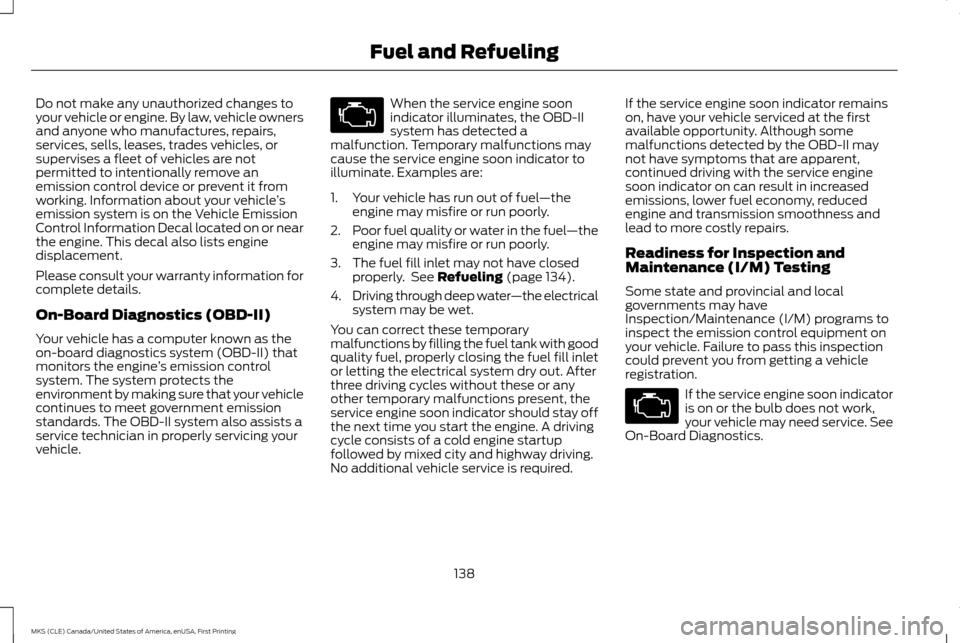
Do not make any unauthorized changes to
your vehicle or engine. By law, vehicle owners
and anyone who manufactures, repairs,
services, sells, leases, trades vehicles, or
supervises a fleet of vehicles are not
permitted to intentionally remove an
emission control device or prevent it from
working. Information about your vehicle
’s
emission system is on the Vehicle Emission
Control Information Decal located on or near
the engine. This decal also lists engine
displacement.
Please consult your warranty information for
complete details.
On-Board Diagnostics (OBD-II)
Your vehicle has a computer known as the
on-board diagnostics system (OBD-II) that
monitors the engine ’s emission control
system. The system protects the
environment by making sure that your vehicle
continues to meet government emission
standards. The OBD-II system also assists a
service technician in properly servicing your
vehicle. When the service engine soon
indicator illuminates, the OBD-II
system has detected a
malfunction. Temporary malfunctions may
cause the service engine soon indicator to
illuminate. Examples are:
1. Your vehicle has run out of fuel —the
engine may misfire or run poorly.
2. Poor fuel quality or water in the fuel —the
engine may misfire or run poorly.
3. The fuel fill inlet may not have closed properly. See Refueling (page 134).
4. Driving through deep water —the electrical
system may be wet.
You can correct these temporary
malfunctions by filling the fuel tank with good
quality fuel, properly closing the fuel fill inlet
or letting the electrical system dry out. After
three driving cycles without these or any
other temporary malfunctions present, the
service engine soon indicator should stay off
the next time you start the engine. A driving
cycle consists of a cold engine startup
followed by mixed city and highway driving.
No additional vehicle service is required. If the service engine soon indicator remains
on, have your vehicle serviced at the first
available opportunity. Although some
malfunctions detected by the OBD-II may
not have symptoms that are apparent,
continued driving with the service engine
soon indicator on can result in increased
emissions, lower fuel economy, reduced
engine and transmission smoothness and
lead to more costly repairs.
Readiness for Inspection and
Maintenance (I/M) Testing
Some state and provincial and local
governments may have
Inspection/Maintenance (I/M) programs to
inspect the emission control equipment on
your vehicle. Failure to pass this inspection
could prevent you from getting a vehicle
registration.
If the service engine soon indicator
is on or the bulb does not work,
your vehicle may need service. See
On-Board Diagnostics.
138
MKS (CLE) Canada/United States of America, enUSA, First Printing Fuel and Refueling
Page 142 of 382
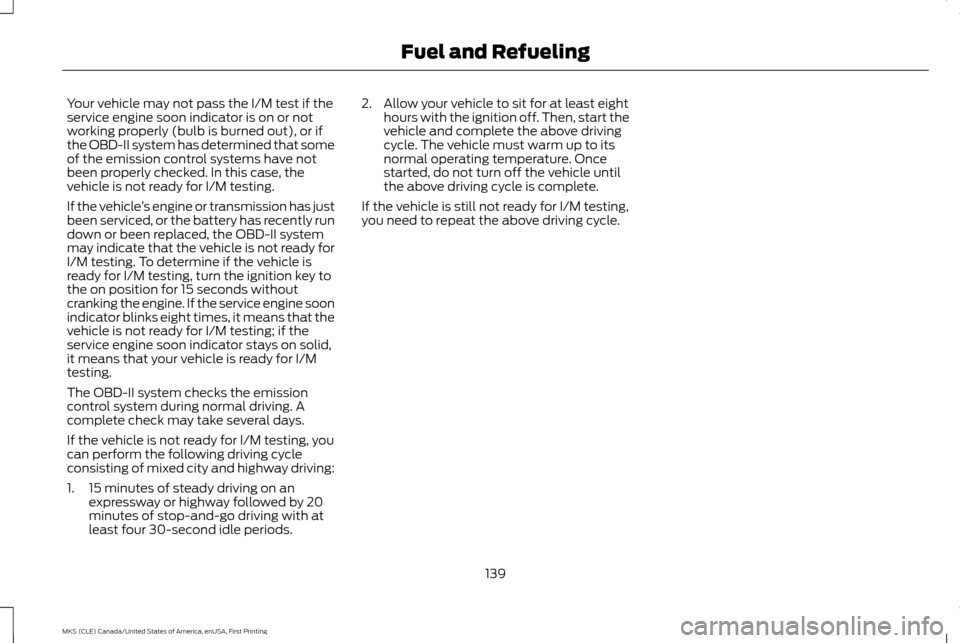
Your vehicle may not pass the I/M test if the
service engine soon indicator is on or not
working properly (bulb is burned out), or if
the OBD-II system has determined that some
of the emission control systems have not
been properly checked. In this case, the
vehicle is not ready for I/M testing.
If the vehicle
’s engine or transmission has just
been serviced, or the battery has recently run
down or been replaced, the OBD-II system
may indicate that the vehicle is not ready for
I/M testing. To determine if the vehicle is
ready for I/M testing, turn the ignition key to
the on position for 15 seconds without
cranking the engine. If the service engine soon
indicator blinks eight times, it means that the
vehicle is not ready for I/M testing; if the
service engine soon indicator stays on solid,
it means that your vehicle is ready for I/M
testing.
The OBD-II system checks the emission
control system during normal driving. A
complete check may take several days.
If the vehicle is not ready for I/M testing, you
can perform the following driving cycle
consisting of mixed city and highway driving:
1. 15 minutes of steady driving on an expressway or highway followed by 20
minutes of stop-and-go driving with at
least four 30-second idle periods. 2. Allow your vehicle to sit for at least eight
hours with the ignition off. Then, start the
vehicle and complete the above driving
cycle. The vehicle must warm up to its
normal operating temperature. Once
started, do not turn off the vehicle until
the above driving cycle is complete.
If the vehicle is still not ready for I/M testing,
you need to repeat the above driving cycle.
139
MKS (CLE) Canada/United States of America, enUSA, First Printing Fuel and Refueling